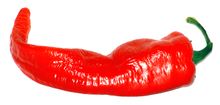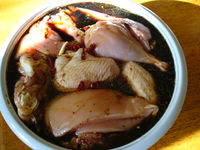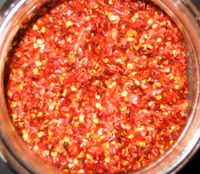Cayenne pepper

A large red cayenne
Cayenne pepper
| Heat |
Hot (SR: 30,000-50,000) |
The cayenne pepper -- also known as the Guinea spice, Cow Horn Pepper, aleva or bird pepper[1] or, especially in its powdered form, red pepper -- is a hot, red chili pepper used to flavor dishes and for medicinal purposes. Named for the city of Cayenne in French Guiana, it is a cultivar of Capsicum annuum related to bell peppers, jalapeños, and others. The Capsicum genus is in the nightshade family (Solanaceae).
The fruits are generally dried and ground, or pulped and baked into cakes, which are then ground and sifted to make the powdered spice known as cayenne pepper.
Cayenne is used in cooking spicy dishes, as a powder or in its whole form (such as in Sichuan cuisine) or in a thin, vinegar-based sauce. It is generally rated at 30,000 to 50,000 Scoville Units. It is also used as a herbal supplement, and was mentioned by Nicholas Culpeper in his 17th century book Complete Herbal.[1]
Cultivation
Most cultivated varieties of cayenne, capsicum annuum, can be grown in a variety of locations and need approximately 100 days to mature. Peppers prefer warm, moist, nutrient-rich soil in a warm climate. The plants grow to about 2–4 feet (0.5–1 metres) of height and should be spaced three feet (1 metre) apart.[2]
Chilis are mostly perennial in sub-tropical and tropical regions; however, they are usually grown as annuals in temperate climates. They can be overwintered if protected from frost, and require some pruning.[3]
Nutrition
Cayenne pepper is high in vitamin A. It also contains vitamin B6, vitamin E, vitamin C, riboflavin, potassium and manganese. [4]
In cuisine

Cayenne peppers used during the marination of
chicken.
Cayenne is a popular spice in a variety of cuisines. It is employed variously in its fresh form, dried and powdered, and as dried flakes. It is also a key ingredient in a variety of hot sauces, particularly those employing vinegar as a preservative.[5]
Name concern

Cayenne crushed red pepper flakes
Cayenne pepper is considered to be a misnomer by the American Spice Trade Association, which prefers the more generic term red pepper. Generally speaking, any of a number of peppers are called cayenne.
See also
References and notes
External links
|
Herbs and spices |
|
|
|
|
|
Spices |
|
Ajwain (bishop's weed) · Aleppo pepper · Alligator pepper · Allspice · Amchur (mango powder) · Anise · Aromatic ginger · Asafoetida · Camphor · Caraway · Cardamom · Cardamom, black · Cassia · Cayenne pepper · Celery seed · Charoli · Chenpi · Chili · Cinnamon · Clove · Coriander seed · Cubeb · Cumin · Cumin, black · Dill & dill seed · Fennel · Fenugreek · Fingerroot (krachai) · Galangal, greater · Galangal, lesser · Garlic · Ginger · Golpar · Grains of Paradise · Grains of Selim · Horseradish · Juniper berry · Kaempferia galanga (kencur) · Kokum · Lime, black · Liquorice · Litsea cubeba · Mace · Mahlab · Malabathrum (tejpat) · Mustard, black · Mustard, brown · Mustard, white · Nigella (kalonji) · Nutmeg · Paprika · Pepper, Brazilian · Pepper, Peruvian · Pepper, long · Peppercorn (black, green & white) · Pomegranate seed (anardana) · Poppy seed · Radhuni · Rose · Saffron · Salt · Sarsaparilla · Sassafras · Sesame · Sichuan pepper (huājiāo, sansho) · Star anise · Sumac · Tamarind · Tasmanian pepper · Tonka bean · Turmeric · Vanilla · Wasabi · Zedoary · Zereshk · Zest
|
|
|
|
Herb and spice mixtures |
|
Adjika · Advieh · Baharat · Berbere · Bouquet garni · Buknu · Chaat masala · Chaunk · Chile (or Chili) powder · Crab boil · Curry powder · Fines herbes · Five-spice powder · Garam masala · Garlic salt · Harissa · Hawaij · Herbes de Provence · Jerk spice · Khmeli suneli · Lemon pepper · Masala · Mitmita · Mixed spice · Old Bay Seasoning · Panch phoron · Persillade · Pumpkin pie spice · Qâlat daqqa · Quatre épices · Ras el hanout · Recado rojo · Sharena sol · Shichimi · Tabil · Tandoori masala · Za'atar
|
|
|
|
Lists of herbs and spices |
|
Australian herbs and spices · Chinese herbology · Culinary herbs and spices · Indian spices · Pakistani spices |
|
|
|
Related topics |
|
|
Marination · Spice rub
|
|
|
|
Capsicum cultivars |
|
| C. annuum |
Aleppo · Anaheim · Ancho · Banana pepper · Bell pepper · Cascabel · Cayenne · Chilaca · Chiltepin · Cubanelle · De árbol · Dundicut · Fresno · Guajillo · Hungarian wax · Italian sweet · Jalapeño · Japanese · Mirasol · Macho · Mulato · New Mexico (Anaheim) · Paprika · Pasilla · Peperoncini · Peter · Piquín · Pimento · Poblano · Puya · Serrano · Tien Tsin |
|
| C. chinense |
Adjuma · Ají Limo · Ají dulce · Datil · Fatalii · Habanero · Red Savina · Madame Jeanette · Naga Jolokia · Scotch bonnet |
|
| C. frutescens |
African Bird's Eye · Bird's Eye chili · Malagueta · Tabasco
|
|
| C baccatum |
Ají · Piquanté · Lemon Drop
|
|
| C. pubescens |
Rocoto
|
|

